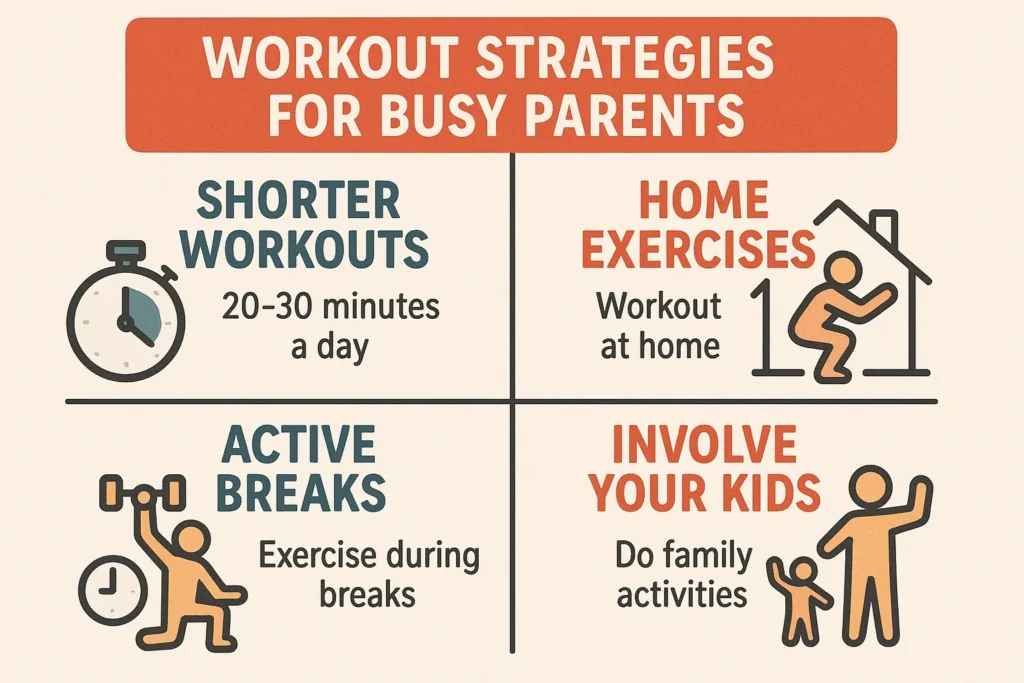the best 4 Workout Strategies for Busy Parents
I got this message the other week, and it felt so. Freaking. Relatable. it’s about Workout Strategies for Busy Parents.
“…the biggest challenge right now is that I am a full-time working mother of two young boys and I’m just so freaking exhausted.
I’m on a hamster wheel of life right now, giving of myself to everyone and everything around me.
It’s not just that it’s hard to find the time to work out…it’s hard to find the energy.
It’s also hard to create a routine I can stick to, one that I can just do without thought, given all the variables in my life.”
Parenting young kids is an especially challenging period of time. There’s a ton of variability in your routine, high demand on your time and attention, and not a lot of energy to spare.
Whether you are a parent, a caretaker, or just going through an incredibly busy season of life, trying to add a fitness routine on TOP of everything else can feel like the Jim Gaffigan joke: “You know what it’s like having five kids? Imagine you’re drowning. And then someone hands you a baby.”
We hear this sentiment all the time with clients in our coaching program.
So today, I want to walk you through exactly how I help them navigate this intense period, while still finding time to work on their health and fitness in ways that feel sustainable to them.
And continuing the “Matt stands in front of a white board in his office and records a video” experiment, I’ve got an accompanying video with notes so you can digest this in whatever format works best for you. (Bonus points to anyone who recognizes where my T-shirt is from!)
And if you are someone who struggles to find consistency with your workouts, reply to this email! I’d love to see how I can help.
The Core Problem – Reframe the “Challenges”

Let’s reframe the problem not as a lack of willpower, but as a design flaw in most workout plans. As a parent, your life has a few predictable “features”:
- The Schedule Shuffle: No two days look the same. Highly variable schedule
- The Attention Tax: You’re pulled in a dozen directions at once. High demands on time and attention
- Energy Bankruptcy: You’re running on empty. Lack of predictable routine.
- The “Normal” Illusion: Waiting for a “normal” week to start is a trap. Unpredictability is the only predictable thing. (Periods of) low energy
I still remember talking with Mike (host of The Chasing Scratch Podcast), and how he kept saying: “This week is crazy, but NEXT week, things will finally get back to normal.”
After several weeks of this, I stopped him and said something along the lines of: “I think unpredictability IS the only predictable thing.”
The Mindset Shift
The goal isn’t to find more time; it’s to make the time you have count. Your fitness routine needs to be as adaptable as you are.
The 4 Adaptive Workout Strategies
Strategy 1: Dial Mode
If we know each day is highly variable, then our plan needs to take that into account.
Start by creating a short and simple bodyweight workout you can do in 5-15 minutes. (Like doing 1 round of this workout.) It becomes a key puzzle piece you can fit into a crazy day.
When I worked at Force Fitness, I remember coming in after a long night with the kiddos, feeling absolutely dead to the world. On these days, my boss and I would look at each other and say: “Turkish Get-Ups and Farmer’s Carries?” Two movements to just get us up and moving for a few minutes, and then cash out for the day.
Strategy 2: Accumulation
Workouts don’t need to happen all at once. You can break up the workout into mini-sessions across the course of the day or even week!
The more important factor is getting the work done, not in the timing.
This is exactly the strategy I use with new parents. We write out a list of exercises, and a target number of reps to get done across the week. Then, they squeeze them in as they can. If you’d like an example of what this looks like, shoot me and email and I’d be happy to share some!
Strategy 3: Me Time
Sometimes, it’s really important to try to carve out time in your schedule to focus on just you. That may mean asking a partner for help, or making some tough decisions about trade-offs. It’s not always possible, but it’s still worth considering.
That’s what we did with my client Michelle. She was having a hard time fitting in workouts, so we walked through some tradeoffs she could make. She asked her partner for support, and was able to carve out 20 minutes after work. She would park outside, and do a workout in the garage. She wasn’t “home” until she walked through the garage door.
Strategy 4: I Go, You Go
If you can’t beat them, join them! Invite the kiddos to participate with you.
Switch your focus to more skill-based or play-based training that may be more engaging for them. Instead of optimizing for “results”, optimize for fun and connection.
This is the option that has been most meaningful in my own life. Part of my big why is connecting with others, and modeling healthy behaviors for my own kiddos. While I still like working out alone, too, finding more ways to involve my family has made the journey all the more rewarding. The goal isn’t a personal record; it’s modeling a healthy lifestyle and having fun with your kids.
You don’t need a perfect plan. You need a flexible one.
This week, don’t try to do it all. Just pick one of these strategies and give it a try. Which one resonates most with your life right now?
If you’re ready to stop the cycle of starting and stopping…
This is exactly what we do in our coaching program. We build a fitness plan that fits your chaotic life, taking the thinking and guesswork off your plate.
Reply to this email or DM me on Instagram [@arnellavanilla] with the word “ADAPT”. Let’s chat about how I can help you build a routine that finally sticks.





